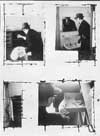… any narrative passage or any passage of poetic images is subject to any number of variations, all of which may be interesting and valid in their own right … cut-ups establish new connections between images. (Borroughs as quoted by Miles, Barry “El Hombre Invisibleâ€)
(link for a playful interlude: cut-up machines)
| Recent private discovery led me finally to look up .. Those crazy “cut-ups” Burroughs, Gysin, and Balch restored to their rightful place in avant-garde film history. In this interesting article I found at www.brightlightfilms.com the author explores the collaborative film work of William Burroughs and Anthony Balch, which brings to cinema an extension of Burroughs’ literary cut-up technique. He, Rob Bridgett, looks at it especially in terms of the various critical and experimental approaches regarding “structural†theory, … |
 |
The Cut Ups was conventionally edited and then cut into four approximately equal lengths. It was then assembled into its final state by taking one-foot lengths from each of the four sections that were cut together with mathematical precision — 1,2,3,4,1,2,3,4 etc. Variations to this structure occur randomly when a shot change occurs within one of the already edited one-foot lengths…
But in its attempt of “deranging the senses†the film when shown to audiences unfamiliar with provocative film practices tended to ‘misunderstanding’s as ..
… reflected in reviews such as the Monthly Film Bulletin’s “a cinematic reductio ad absurdum, a mechanical and quite pointless exercise.” And regarding the soundtrack, “simple phrases repeated ad nauseam.” Ignored were the nihilistic aspects of the film and its confrontational approach to audience and language/logic as a control system….
Nevertheless in this context, Burroughs and Balch can be seen as ..
.. revealing the actual structure of writing and cinema, while also creating new juxtapositions and fresh and hidden meanings in the texts. This predates the “structural film’s†concepts and does not pursue the political, Marxist positions of Gidal et al. of losing content. Rather, the cut-up creates new, poetic, crippled syntax and reflects a basic concern with narrative juxtaposition.
… and follow through to the interesting comparison and conclusion:
The very semantic nature of the term “structural†[..] refers not only to simple, minimal structures, but as a general term that can be divided into complex (polymorphic) and simple (monomorphic) structures…
Burroughs’ and Balch’s
… approach being wholly different in that their concern is with content. They are not concerned with the imaginary status of the cinematic signifier, only with fresh propinquity of narrative elements. The results may often seem nonsensical, but they represent the new antirational meanings sought by the cut-up operative. This concern with relationships between units of meaning reflects Vertovian concepts of cinematic expression and Kubelka’s serialist musical heritage and its approach to film.
… “It is the interval between two frames which is the important element of the articulation of meaning.” … (Vertov, Dziga “We Manifestoâ€)
The Cut-Ups’ concern also clearly remains in this tradition, bringing disparate elements into collision spatially and temporally with the effect of focusing attention onto the importance of the new relationships. …
.. The Cut Ups can therefore be divided into two different approaches. The first approach is the concern with rigorously applying a monomorphic cutting structure to film footage and creating new arbitrary relationships between units, linking hitherto unrelated linear shots into a new spatio-temporal whole. The strongly rhythmic visual cuts play a particularly interesting role, especially when considered as anti-rhythmic elements in relationship to the soundtrack’s constantly shifting tempo. …
link for entire article
and Borroughs on UBU

